ESG Topics A-Z
Climate change

To PepsiCo:
Climate change poses significant risks to our business and the communities where we operate. It can impact the quantity and quality of agricultural raw materials available for our products, create weather patterns that affect the operation of our facilities and supply chain and affect the availability and quality of water. Mitigating our contribution to climate change, adjusting our business models and preparing our operations to adapt to climate impacts can help us to build a more resilient business equipped to navigate the realities of the future.
To the World:
Implementing solutions to address climate change is important to the future of our company, customers, consumers and our shared world. The potential secondary impacts of climate change are vast, interconnected and far-reaching, and include geopolitical instability, food scarcity and public health crises. Taking action to decouple economic growth from carbon emissions is the path toward a better future.
Approach
Our world is already feeling the effects of climate change and faster, bolder action is needed. We not only have an interest in reducing greenhouse gas (GHG) emissions for the benefit of society — it’s also crucial to the viability of our business, as we are already experiencing the impacts of climate change within our supply chain.
PepsiCo's Climate Action Strategy
PepsiCo’s climate action strategy is centered around two pillars:
- Mitigation: Reducing GHG emissions with the aim to decarbonize our operations and supply chain; and
- Adaptation: Reducing vulnerabilities to the impacts of climate change by continuing to incorporate climate risk and adaptation in our business continuity plans and risk management processes.
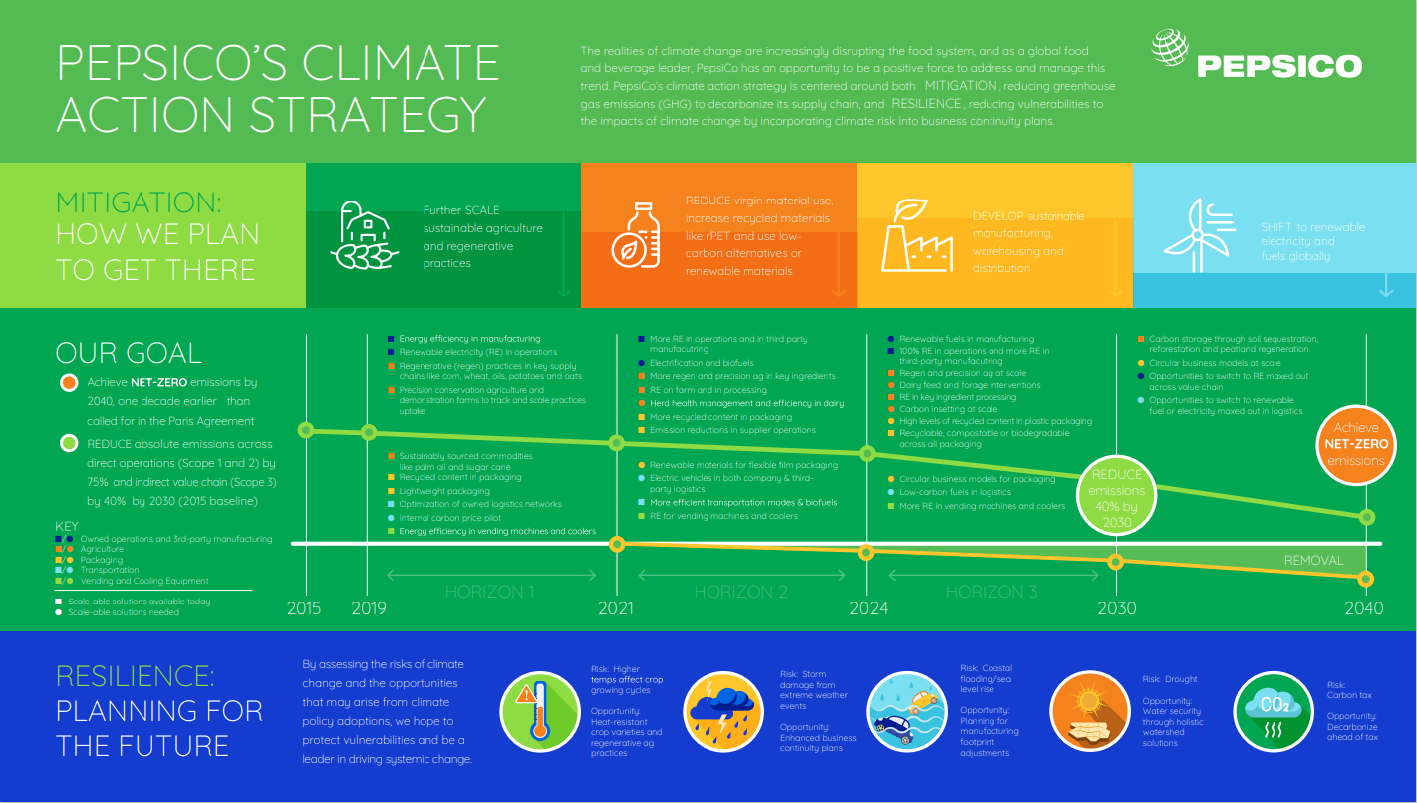
Our strategy focuses on the areas in which we have the greatest impact — manufacturing, agriculture, packaging and transportation. It endeavors to use scalable solutions that are available today, but also acknowledges that achieving net-zero emissions by 2040 will likely require new technologies and mechanisms. To this end, we continue to invest in promising solutions.
The challenges in this journey are significant and complex, and we have work to do to achieve our vision. But, we remain focused on trying to drive change through our pep+ (PepsiCo Positive) agenda and striving to reduce the linkage between our business and emissions growth.
Mitigation
We aim to reduce absolute GHG emissions across our value chain by more than 40% by 2030 against a 2015 baseline, including a 75% reduction in emissions from our direct operations (Scope 1 and 2) and a 40% reduction in indirect emissions from our value chain (Scope 3). In addition, we’re working to achieve net-zero emissions by 2040, one decade earlier than called for in the Paris Agreement. Our target aligns with the Business Ambition for 1.5°C pledge, which PepsiCo signed in 2020, joining other leading companies to set science-based emissions reduction targets in line with limiting global warming to 1.5°C above pre-industrial levels.
As we work to reduce GHG emissions in our operations and supply chain, we are focusing our ongoing efforts on four key areas:
- Developing sustainable manufacturing, warehousing and distribution strategies;
- Further scaling sustainable agriculture and regenerative practices;
- Reducing the impact of our packaging; and
- Shifting to renewable electricity and fuels across our value chain.
Our strategy to achieve our 2030 emission reduction goal does not include the purchase of carbon offsets. We plan to achieve our 2040 net-zero goal by ensuring significant emission reductions within our value chain first, then balancing residual emissions with limited use of carbon offsets.
Our current and future efforts to reduce emissions build on the groundwork we laid during our first generation of Performance with Purpose goals in 2006, enhanced by a second series of goals in 2015 and culminating in our expanded goals introduced with pep+ in 2021.
Adaptation
Climate change is already producing significant impacts including temperature extremes, adverse weather events, droughts and coastal flooding. Without significant intervention, these are only expected to increase in severity and frequency. While climate change represents a risk to our business, there is also opportunity to drive resilience in the face of these events. In line with our Climate Action Strategy, we regularly assess the various risks and opportunities associated with climate change that our business faces. This helps PepsiCo to safeguard against vulnerabilities and to work toward driving systemic change.
As part of our agriculture strategy, we continue to partner with farmers to drive the adoption of regenerative agriculture. These practices, including planting cover crops and adopting low- or no-till techniques, may help to reduce on-farm GHG emissions and improve the resilience and sustainability of our crop supply.
This work extends beyond our supply chain, as we recognize that the effects of climate change are often felt by the most vulnerable members of society. As we work to build resilience for our business and supply chain, we also strive to support a Just Transition for these vulnerable groups, maximizing the social and economic opportunities stemming from our Climate Action Strategy, while minimizing and carefully managing the risks. Doing so requires effective stakeholder engagement among impacted groups and respect for fundamental labor principles and rights. As an example, our water replenishment work in high water-risk watersheds helps to support a secure water supply for communities in areas where climate change puts water availability at risk. This includes projects in South Africa, India, Pakistan, Mexico and the western U.S.
Risk management and scenario analysis
Informing our adaptation work is our Integrated Risk Management Framework, a process that identifies, assesses, prioritizes, manages and monitors the risks affecting the Company across its operations — including climate change. Long-term climate risks are considered by both the PepsiCo Board of Directors, including its Sustainability, Diversity and Public Policy Committee and the PepsiCo Risk Committee. This means that specific actions are performed in order to identify the risk indicators and a mitigation plan is developed with the aim to protect the Company from the worst impacts.
In line with the recommendations of the Task Force on Climate-related Financial Disclosures (TCFD), we have completed and, in 2023, updated our climate scenario analysis to identify climate-related risks and opportunities. The analysis considered PepsiCo’s wholly-owned assets (such as manufacturing plants, warehouses, R&D centers and offices), our third-party manufacturing assets (e.g., franchise and joint venture arrangements), as well as our agricultural supply chain locations. The results help us to:
- View our business within various temperature (business as usual, 2°C increase, and for company-owned manufacturing operations 1.8°C increase scenarios) and timeframe (2020-2100) scenarios. 1.5°C scenario modeling was not available through our risk assessment vendors for transition risk during the initial assessment, however, we intend to include it in our next update.
- Identify our hotspot areas in terms of climate impacts — both physical (e.g., owned and third-party assets, wildfire) and transitional (e.g., carbon price, technological changes).
- Strengthen our resiliency planning (e.g., incorporating climate risk into our capital allocation decisions).
In 2023, we re-ran our scenario modeling for company-owned manufacturing facilities using latest modeling capabilities. We modeled three physical climate risk scenarios for a variety of risks such as flooding, heat stress, water stress, wildfire and high wind speed, among others. We plan to update our analysis with updated internal information and methodologies every 2-3 years.
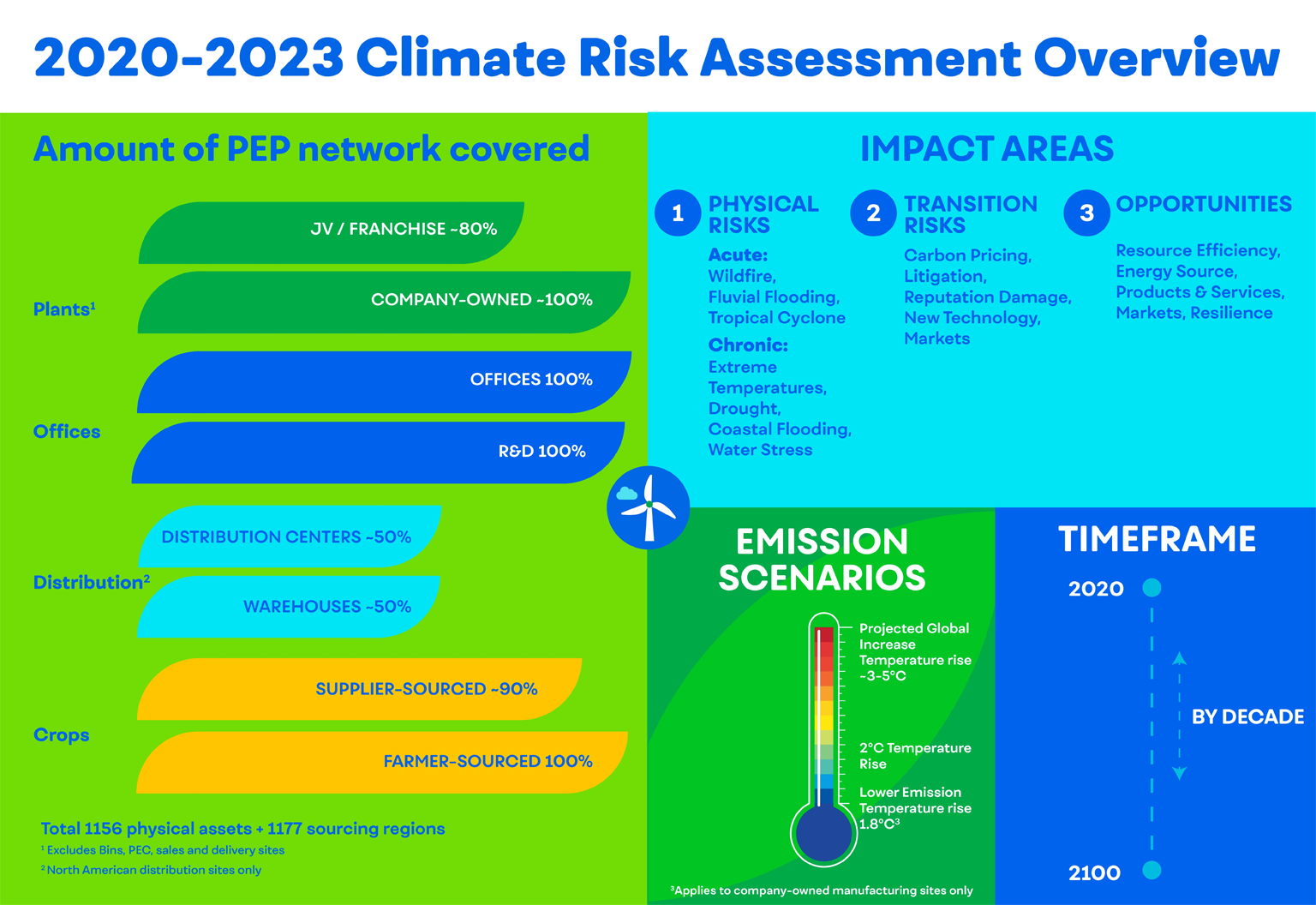
Governance
PepsiCo's Global Sustainability Office, led by the company’s Chief Sustainability Officer, is charged with coordinating and informing the company’s sustainability agenda across our value chain. Serving as the central connection point, the Sustainability Office works closely with leaders from across the business to drive continued progress against our climate change agenda and embed sustainability into our long-term strategic planning.
The Board plays an essential role in determining our strategic priorities and considers sustainability issues (e.g., climate change) as an integral part of its business oversight. To this end, the Board established a Sustainability, Diversity and Public Policy Committee to assist in providing more focused oversight of key sustainability, diversity, equity and inclusion and public policy matters. One of the primary responsibilities of the Committee is to review PepsiCo’s key sustainability programs and related goals and monitor the Company’s progress toward achieving those goals, including progress against climate ambitions.
At one level below the Board, the PepsiCo Executive Committee (PEC), made up of the Chairman & CEO, the CFO, sector CEOs and functional heads, meets regularly to review progress against goals; progress against broader environmental risk mitigation (such as our efforts to mitigate the impacts of climate change); and to ensure that we are adapting our sustainability strategy to changes in science, stakeholder expectations and marketplace conditions. Additionally, strategy and progress against our sustainability goals are reviewed during bi-monthly meetings of the Sustainability Committee — an Executive Committee sub-committee comprised of members of our senior leadership management team. This provides opportunities for our senior leadership to align on major strategic issues relating to sustainability, including climate change, and keep sustainability in focus among competing priorities. For more information about our governance practices, see Sustainability governance.
Resource allocation
Meeting our climate ambitions will require investment, not only of employees’ time and capability, but also of financial resources to support scalable solutions and catalyze new technologies. Each year, a cross-functional team comprised of climate subject matter experts, as well as the sustainability strategy and strategic investments teams comes together in an effort to identify solutions to help them achieve our climate goals, and to ensure these are funded. We utilize a variety of mechanisms to drive climate investments:
The first of these is our Sustainability Capital Expenditures (CapEx) Fund. Through the fund, we aim to invest in projects that support our sustainability ambitions but that may not meet our internal desired rate of return.
A second lever — our Green Bonds — is helping to fund these projects, and others, to advance critical steps in our sustainability journey. The eligible decarbonization expenditure from our first Green Bond has helped to increase our renewable energy generation capacity and put technology in place to avoid more than 230,000 metric tons of GHG emissions in our direct operations and supply chain annually. Our second Green Bond, issued in July 2022, continues to fund climate work, including the adoption of regenerative agriculture practices. Through investments in energy-efficient technologies and equipment, expenditure from our second Green Bond is estimated to avoid the emission of approximately 60,000 metric tons of greenhouse gases per year.
Additionally, we maintain a Climate Outcomes Fund which targets investments that aim to reduce our Scope 1 and Scope 3 greenhouse gas emissions footprint. The fund is centralized, managed by the Sustainability Office, but provides funding across the business in any sector, as long as the projects are scalable and can be replicated in other markets. For our offices and operations, the Site Sustainability Fund provides funding to implement sustainable solutions like recycling centers and compost programs.
Outside of our walls, we aim to incentivize suppliers through our joint, ESG-linked supplier financing program with Citibank in key international markets. The program offers PepsiCo suppliers a discounted rate on supply chain financing solutions if they reach certain ESG targets. Targets include undergoing a GHG assessment as well as — for more mature suppliers — optimizing the management of environmental resources or meeting thresholds on sustainable sourcing. After launching in Brazil in 2022, we’re looking to expand the program.
For more information on our efforts to finance sustainability efforts, including climate mitigation and adaptation projects, see our annual Green Bond Report.
PepsiCo and climate policy advocacy
Climate change is one of the most important issues of our time and requires immediate, coordinated action.
We believe industry and governments should commit to science-based action to keep global temperature increases to well-below 2°C or 1.5°C above pre-industrial levels, as described by the Special Report on Global Warming of 1.5°C of the Intergovernmental Panel on Climate Change.
To combat climate change, emitters need effective and widely-adopted climate policy that creates clear price signals and incentives to accelerate sustainable technology, regenerative agriculture and needed innovation. PepsiCo has an extensive public record of supporting climate policy through actions including:
- Signing the American Business Act on Climate Pledge
- Signing the We Are Still In declaration in support of the Paris Agreement
- Becoming a founding member of the U.S. Climate Leadership Council
- Endorsing the World Economic Forum’s Alliance of CEO Climate Leaders statements on climate policy
- Endorsing the We Mean Business climate action letter to the G20
- Signing the Global Renewables Alliance letter calling for a target at COP28 to triple renewable energy capacity by 2030
- Voicing support for the European Green Deal
We applaud the recent push at the U.S. federal level to bring forward a wide range of climate policies that would help transition the U.S. to a low-carbon economy, and we share in the urgency to enact these measures. Given our goals supporting renewable energy, regenerative agriculture, clean transportation and circular use of materials, we are especially encouraged by the measures that would spur clean electricity, expand programs for farmers to adopt regenerative practices, accelerate investment in electric vehicles and infrastructure and help finance closed-loop recycling systems, all of which will enable significant reductions in carbon emissions.
PepsiCo's vision is to support a sustainable environment and economy through meaningful climate action, and we call on governments around the world and all climate action advocates, including businesses and trade associations, to work constructively and with urgency to raise the bar on national climate policy. For more on our policy engagement, see Public policy engagement, political activities and contributions guidelines.
Measuring our impact
We complete an annual corporate greenhouse gas inventory to evaluate the global GHG footprint of our operations (Scopes 1 and 2) and value chains (Scope 3). Our inventory follows leading industry guidance established by the GHG Protocol. We use the inventory results to try to identify emissions hotspots and to develop and prioritize actions that aim to reduce emissions across our value chain. Emissions inventories have also been used to establish PepsiCo’s global climate ambitions.
Scope 1 and 2 emissions
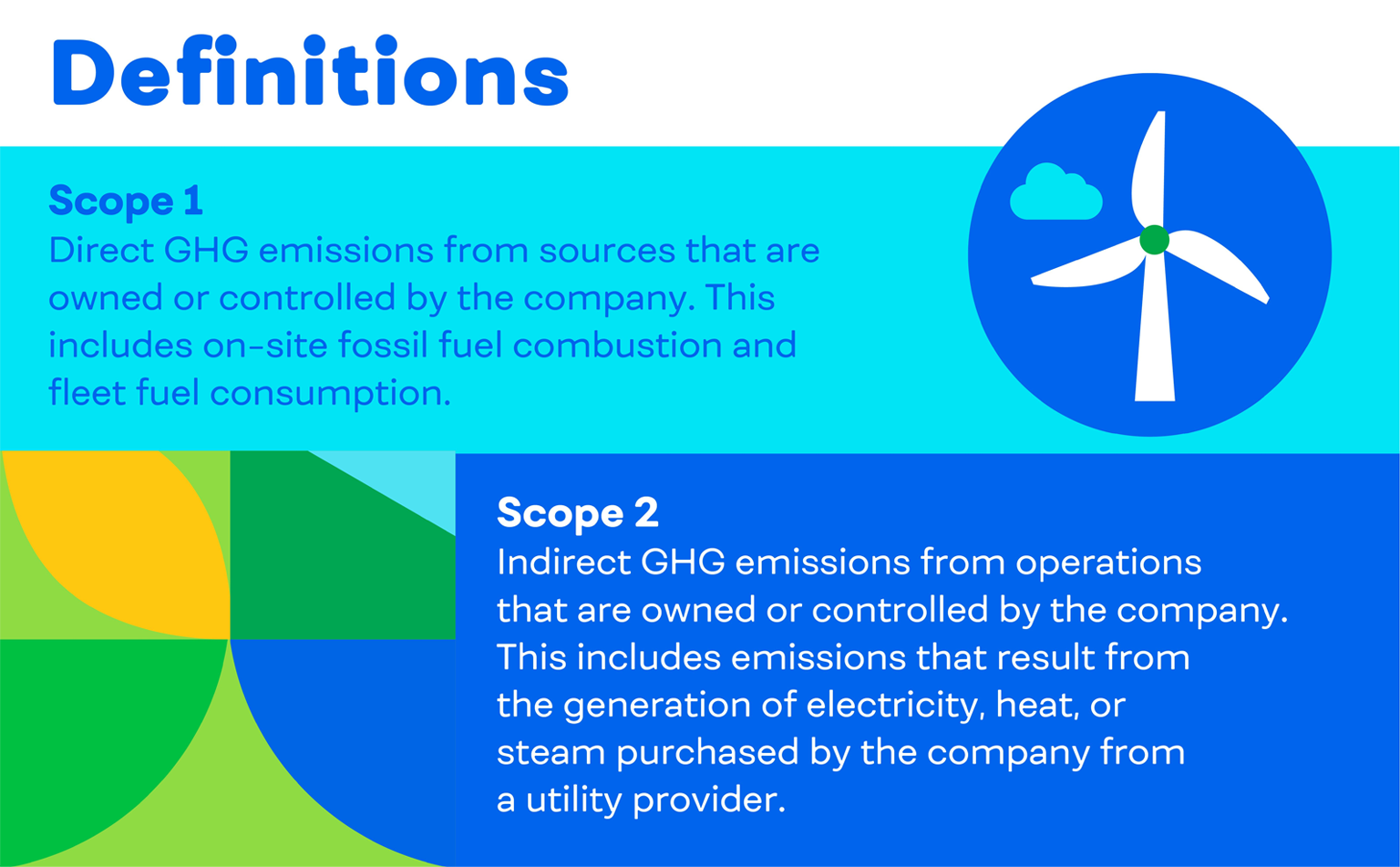
Our Resource Conservation (ReCon) program is a comprehensive, global platform of resources, tools and programs aiming to improve energy, water and waste efficiencies in our manufacturing and warehousing operations. Through a combination of training and technology, ReCon identifies opportunities to reduce fuel and electricity consumption with a focus on deploying energy efficient lighting, heating and cooling systems, boilers and motors, as well as trying to drive behavioral improvements through operator training.
Additionally, continued developments in fleet technology, including aerodynamics, more efficient powertrains and GPS/telematics will further drive fleet fuel efficiency. We are further improving the GHG intensity of our manufacturing and fleet operations through the use of alternative and renewable fuels, such as renewable compressed natural gas and biomass from sustainable sources, as well as transitioning to zero-emissions vehicles supported by renewable electricity purchased or generated on-site. See Fleet decarbonization for more on those efforts.
We are working on transitioning to procuring 100% renewable electricity globally. We plan to do this first across our company-owned operations by 2030, with an aim for our entire global operations, including franchisees, by 2040, including renewable energy credits. Reaching these goals will require a combination of tactics. Where feasible, we will install renewable energy on-site or purchase renewable energy through Power Purchase Agreements (PPAs) or with Energy Attribute Certificates (EACs). For more on our approach and progress, see Renewable energy.
Across our operations, we have outlined a set of principles, Sustainable Operations from the Start (SOftS), that requires all new operations, including building new manufacturing and distribution sites as well as expanding lines within existing operations, to be funded, scoped and activated with net-zero emissions and net water positive outcomes in mind.
Scope 3 emissions
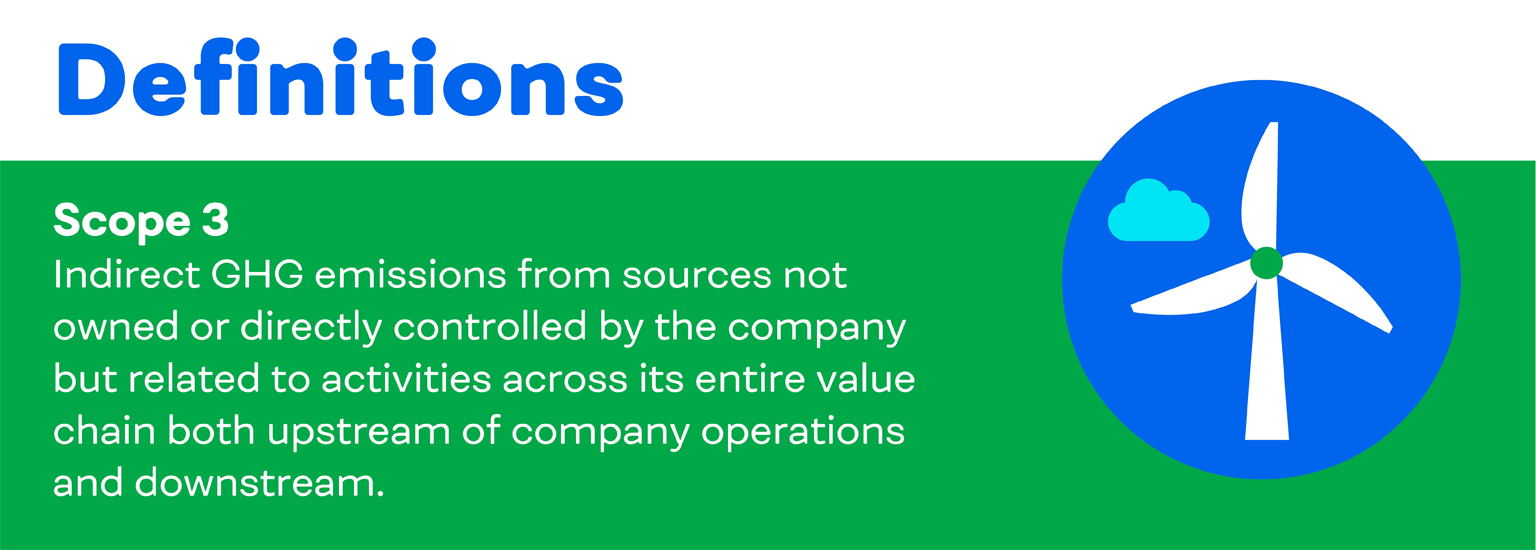
Our efforts to reduce value chain emissions focus on our three largest emissions drivers: agriculture, packaging and third-party transportation and distribution. Combined, these three sources accounted for 75% of our global GHG emissions in 2023, and striving toward our net-zero goal requires that we move quickly and significantly on these in collaboration with our upstream and downstream partners from whom these emissions originate.
Our agriculture climate strategy goes hand-in-hand with our Positive Agriculture goals. Through it, we aim to work with farmers to embed practices that lead to better yields, improved soil health, lower deforestation and also lead to GHG emission reductions. We are therefore focusing on sourcing strategies for our key ingredients like palm oil and cane sugar, as well as collaborating with suppliers, peers and other stakeholders to implement and influence better on-farm practices. Additionally, we are engaging our key agricultural suppliers in an effort to increase the use of renewable electricity and fuels to reduce the GHG footprint in agricultural processing.
Packaging is another aspect of our pep+ ambition with a clear link to our climate goals. To reduce packaging impact, we aim to incorporate more recycled content and striving to make our packaging recyclable, compostable, biodegradable or reusable. We are also reducing the weight of packaging material, introducing alternative materials and exploring alternative business models that eliminate or significantly reduce packaging. Furthermore, we are engaging our key packaging suppliers aiming to accelerate the adoption of clean energy solutions to reduce the GHG emissions of packaging materials.
Within third-party transportation and distribution, we aim to improve the efficiency and carbon intensity of the non-PepsiCo fleet that moves our products. By mapping and quantifying our baseline emissions from third-party carriers and engaging with our carriers, the U.S. EPA's Smartway program and industry alliances like the Smart Freight Buyers Alliance, we are identifying opportunities for improvement within our carrier base. These include working with our carriers to adopt efficiency measures, use sustainable biofuels and transition to zero-emissions vehicles such as electric vans and trucks.
Underpinning these focus areas is supplier engagement because a portion of our Scope 3 emissions lie within our direct tier 1 suppliers' operations.1 At our 2023 annual global Supplier Summit, we laid out four climate-related expectations and asked our top 200 suppliers2 to:
- Set or commit to set a Science-Based Target (SBT);
- Share an SBT-aligned decarbonization plan and annual progress;
- Report Scope 1 & 2 emissions; and
- For agricultural suppliers, collaborate with PepsiCo to develop an action plan for sustainable ingredients and to build regenerative agriculture acres.
When these suppliers track and measure their GHG impacts, we benefit from more accurate emissions calculations. As our suppliers begin work to improve their emissions footprints through operational efficiencies and renewable energy use, we anticipate a reduction of our Scope 3 emissions.
Our strategy for supplier engagement is a continuous improvement process based on three key elements: understand, design and build capability through meaningful actions. PepsiCo engages our highly mature suppliers one-on-one at the leadership level in order to align on priorities and collaborative initiatives. We also partner closely with our tier 1 suppliers1 to address the further upstream emissions, whether on-farm or in raw material extraction. Such collaborations are expected to lead to a reduction in Scope 3 emissions not only for PepsiCo, but also for our suppliers.
In addition to our focus areas, we are also trying to address emissions through additional initiatives:
- Engaging our third-party manufacturers in an effort to bring them along on our climate action journey. Our third-party manufacturers include our franchise bottlers, non-controlled joint ventures, co-manufacturers and co-packers. Improving their operational efficiency will also have an impact on PepsiCo’s Scope 3 emissions.
- Continuing Sustainable from the Start, an environmental sustainability impact assessment program for our product development process. The program includes a toolkit and business processes that help to build the capability within our various functions involved in product innovation to understand the environmental and climate impacts of product design and to make sustainable choices. In doing so, they are supporting our strategic, long-term vision to decouple our business from fossil fuels. To learn more, see Sustainable product design.
- Collaborating with agricultural suppliers aiming to develop on-farm regenerative agriculture solutions, identify improvements in operational efficiencies and source renewable electricity.
Note on methodology
Tracking, calculating and reporting the greenhouse gas emissions for a company of PepsiCo’s size is complex. Emissions, and Scope 3 emissions in particular, are calculated with the aid of estimates, regional or country-specific emissions factors developed through life-cycle assessment methodologies and modeling to arrive at a reasonable value. For our annual reporting, we rely on many external rules, standards and data sets — developed by experts in GHG accounting for their fields. We aim to use the best available methodologies and are continually refining our approach to calculating our emissions. For specific detail on how progress against each of our goals is calculated and validated, see Calculation methodology and ESG data governance. PepsiCo’s GHG footprint is subject to change as a result of major updates to our operational footprint, particularly when the company completes acquisitions or divestitures, or when improved data, methodologies or emissions factors become available.
pep+ in context: Climate
Achieving our net-zero ambition will require unlocks across key internal and external factors.
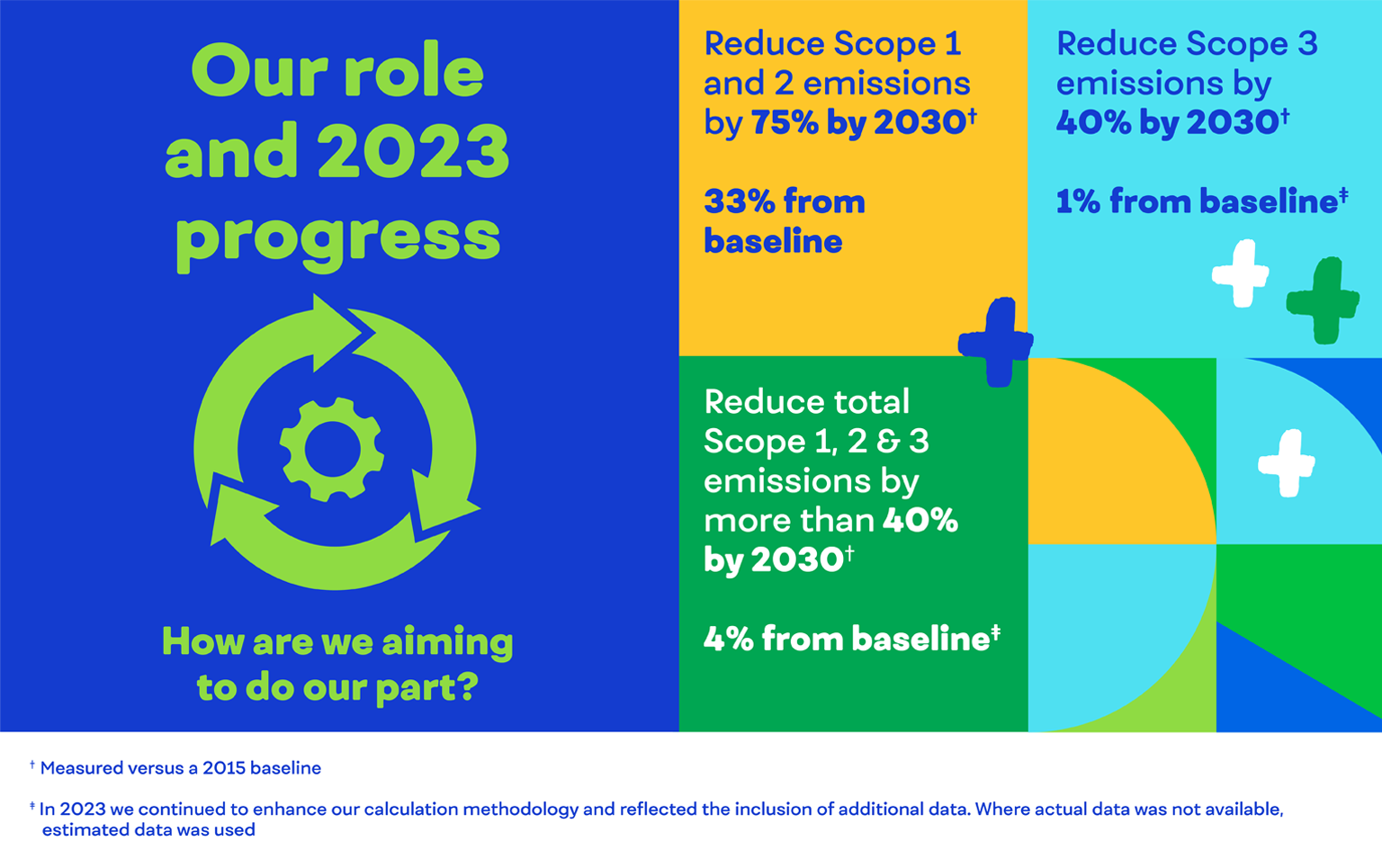
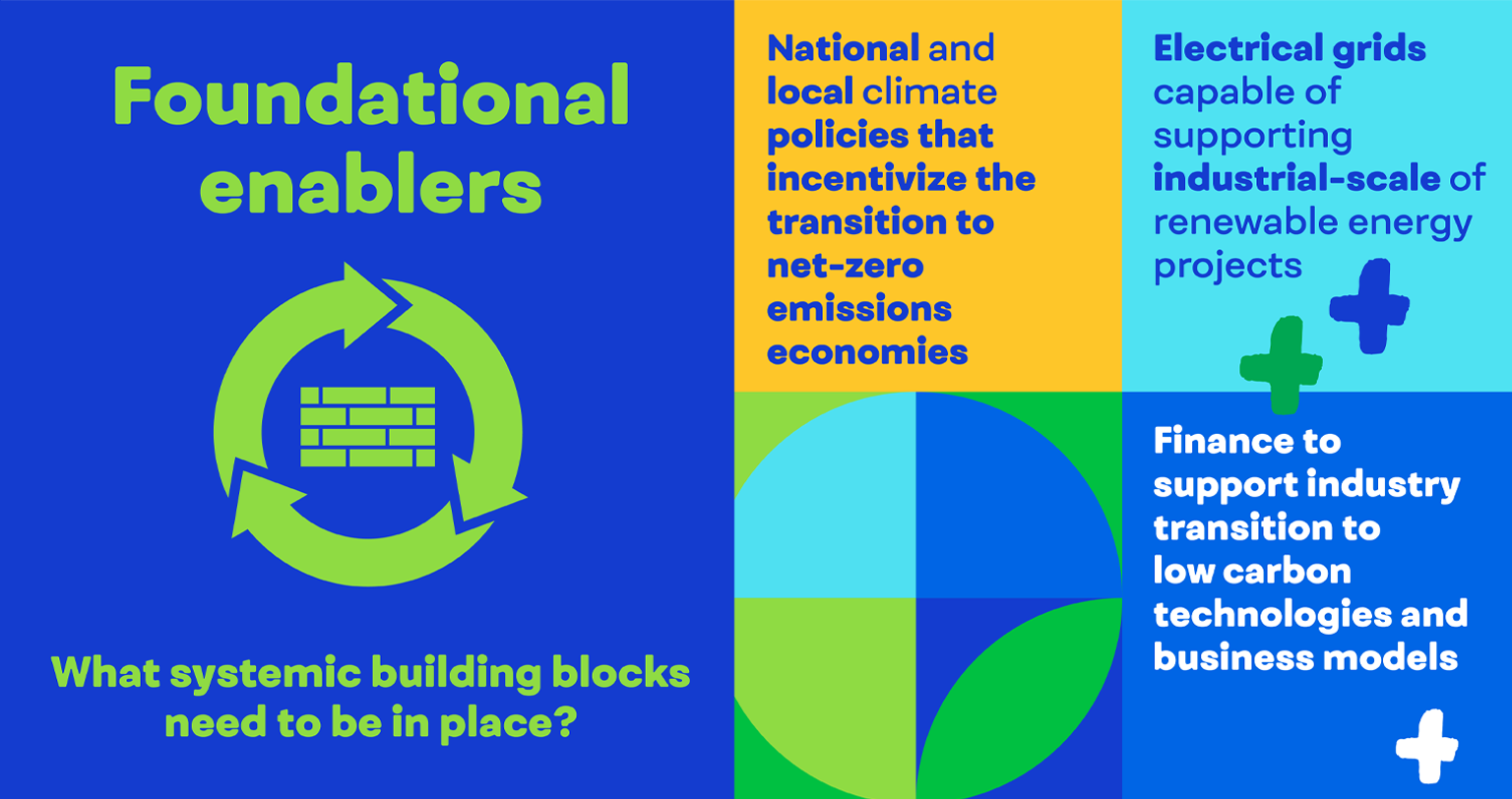
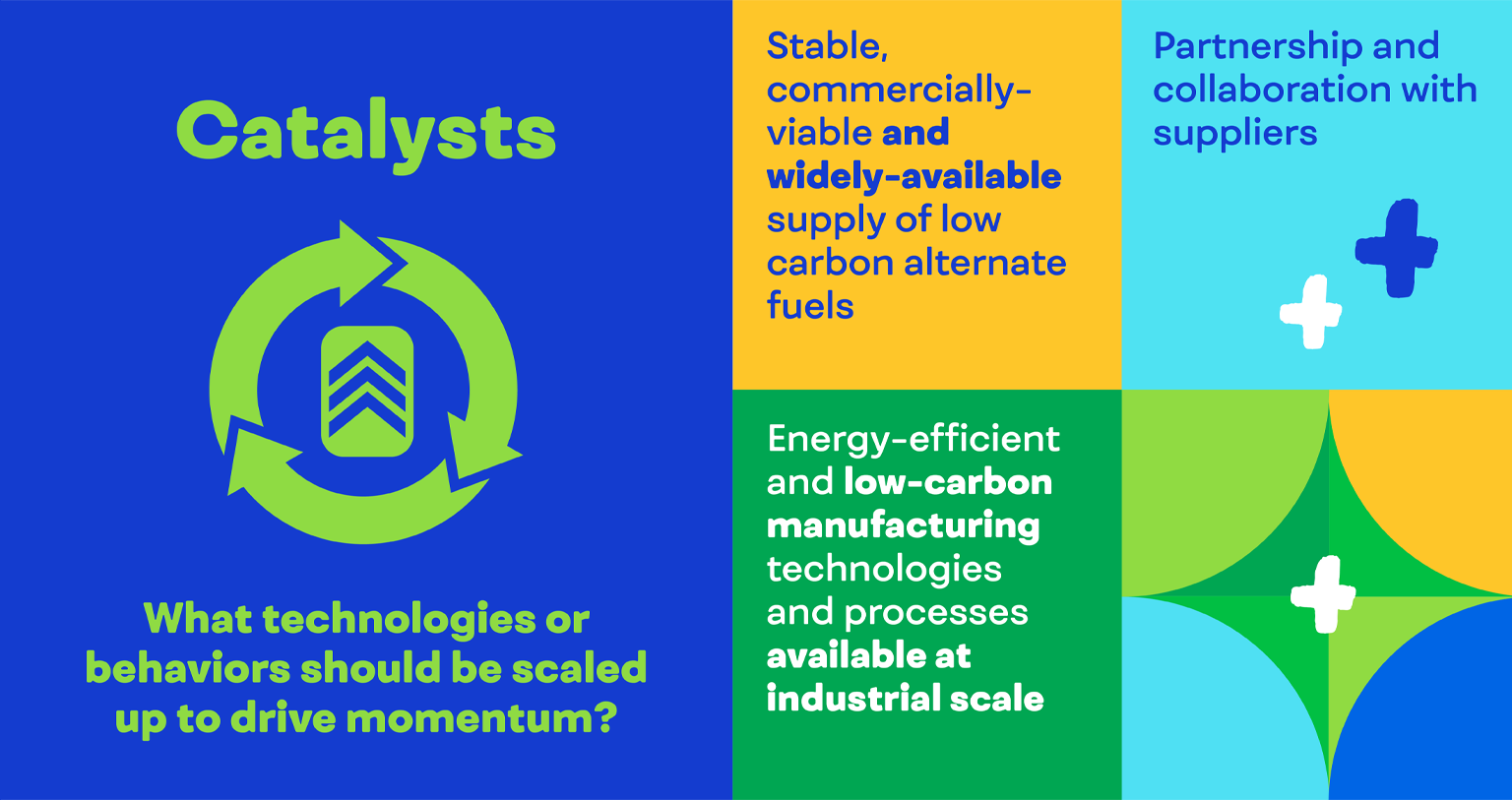
Progress
In 2023, PepsiCo’s total GHG emissions across Scopes 1, 2 and 3 were approximately 58 million metric tons, which represents a 4% decrease from the 2015 baseline and a 5% decrease from 2022.3 While this represents year-over-year progress and slight progress towards our 2030 ambitions, it illustrates a common challenge for companies combating climate change: reducing emissions while maintaining business growth. Decarbonizing our value chain is a complex effort requiring a multi-pronged approach and the commitment of stakeholders as diverse as suppliers, regulators, customers and consumers. We know that our efforts do not occur in a vacuum — they rely on the developments of the wider systems in which we operate. Key areas, such as modernization of electrical grids and development of affordable renewable fuel supply, will influence our progress as we work towards decarbonization. We’ve learned a lot as we’ve tested technologies and we aim to continue to implement scalable solutions that are available today, while also investing in new promising technologies. Our Scope 1 and 2 GHG emissions continue to decline, however slower-than-anticipated technological developments for Scope 1 solutions like renewable fuels have dampened progress.
Progress towards our climate and renewable electricity goals is being achieved in part by building on-site solar and wind installations at our plants and distribution centers, coordinated by local and sector teams. We also execute Power Purchase Agreements (PPAs), which finance the development of new renewable electricity projects such as solar and wind farms, and purchase energy attribute certificates (EACs), known as renewable energy certificates (RECs) in the U.S. EACs and RECs from existing wind or solar farms are certified by independent third parties that support existing electricity generation from renewable sources before being included in our portfolio of renewable electricity. Unbundled RECs enable companies to support the renewable energy market and renewable energy generation and their use is a common first step in the renewable electricity journey. We anticipate increasingly transitioning to longer-term renewable electricity solutions such as PPAs and on-site generation over time.
Delivering our products requires certain key inputs and activities whose emissions we cannot always control or even influence. This includes the crops that make up our products, the packaging that holds them and parts of the transportation system that delivers them to our customers. We know that turning the tide will take diligence and time, but we are laying the foundation by putting substantial influence and investment behind climate action and building resilience in our own operations and beyond. Though progress has not always been fast, we are seeing movement in these hard-to-move spaces. Emissions from vending and cooling, for example, declined 63% between 2015-2023 as a result of continued investment in energy efficiency and more recently in renewable electricity, and have contracted from 10% to 4% of our total GHG emissions during that period. And despite strong sales volume growth between 2015-2023, our Scope 3 emissions have decreased approximately 1% during the same timeframe.
Consistent with previous years, the majority of our carbon footprint (94%) comes from our value chain, or Scope 3 emissions, particularly these three categories: agriculture (37%), packaging (26%) and third-party transportation and distribution (11%).
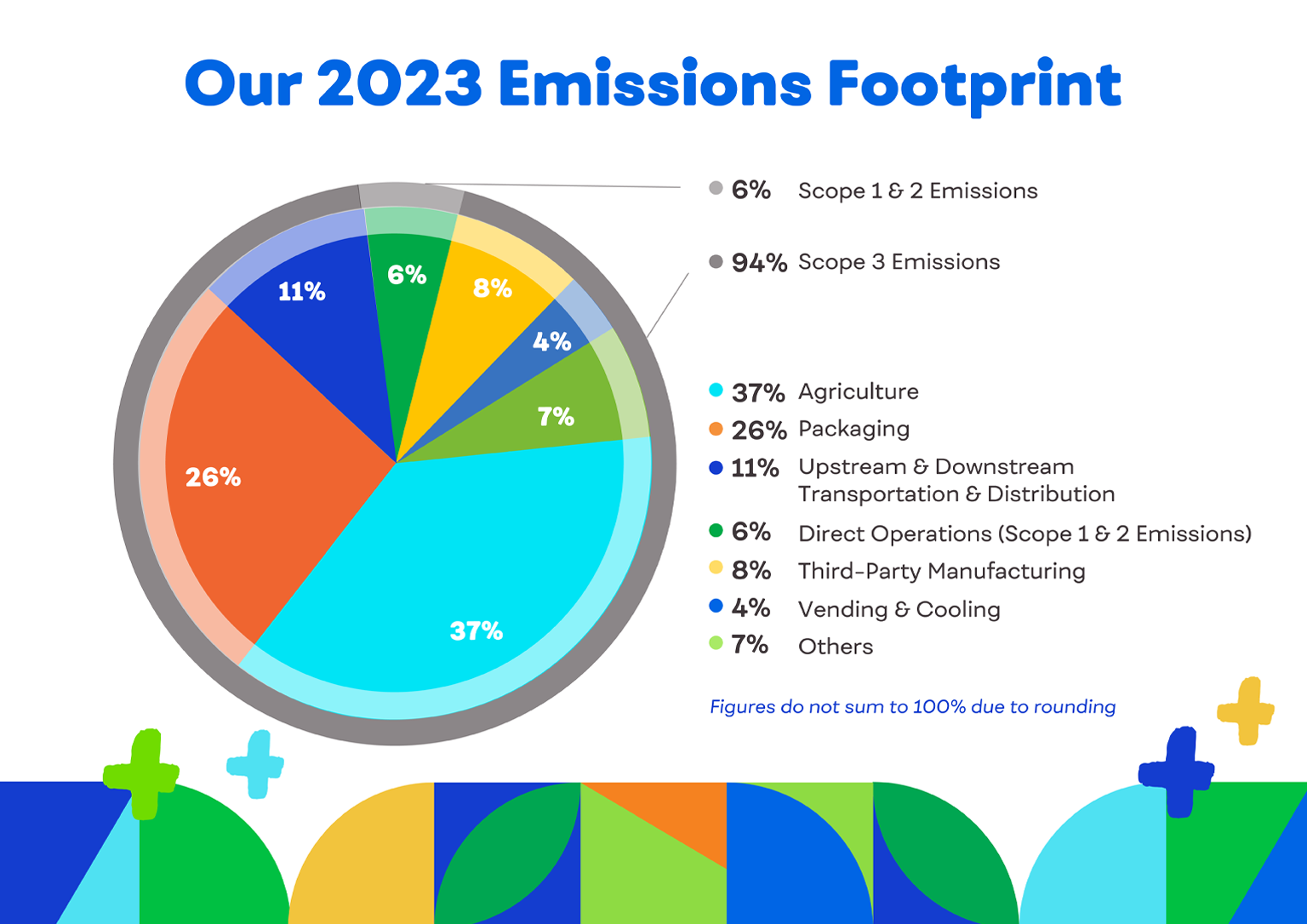
Our emissions intensity (calculated as million metric tons GHG emissions per $ billion net revenue) was 0.64 in 2023, compared to 0.96 in 2015, reflecting net revenue growth that outpaced our emissions increase.3,4 Accelerating this downward trend will be key to striving to meet our 2030 climate goals and ultimately achieve our 2040 net-zero ambition.
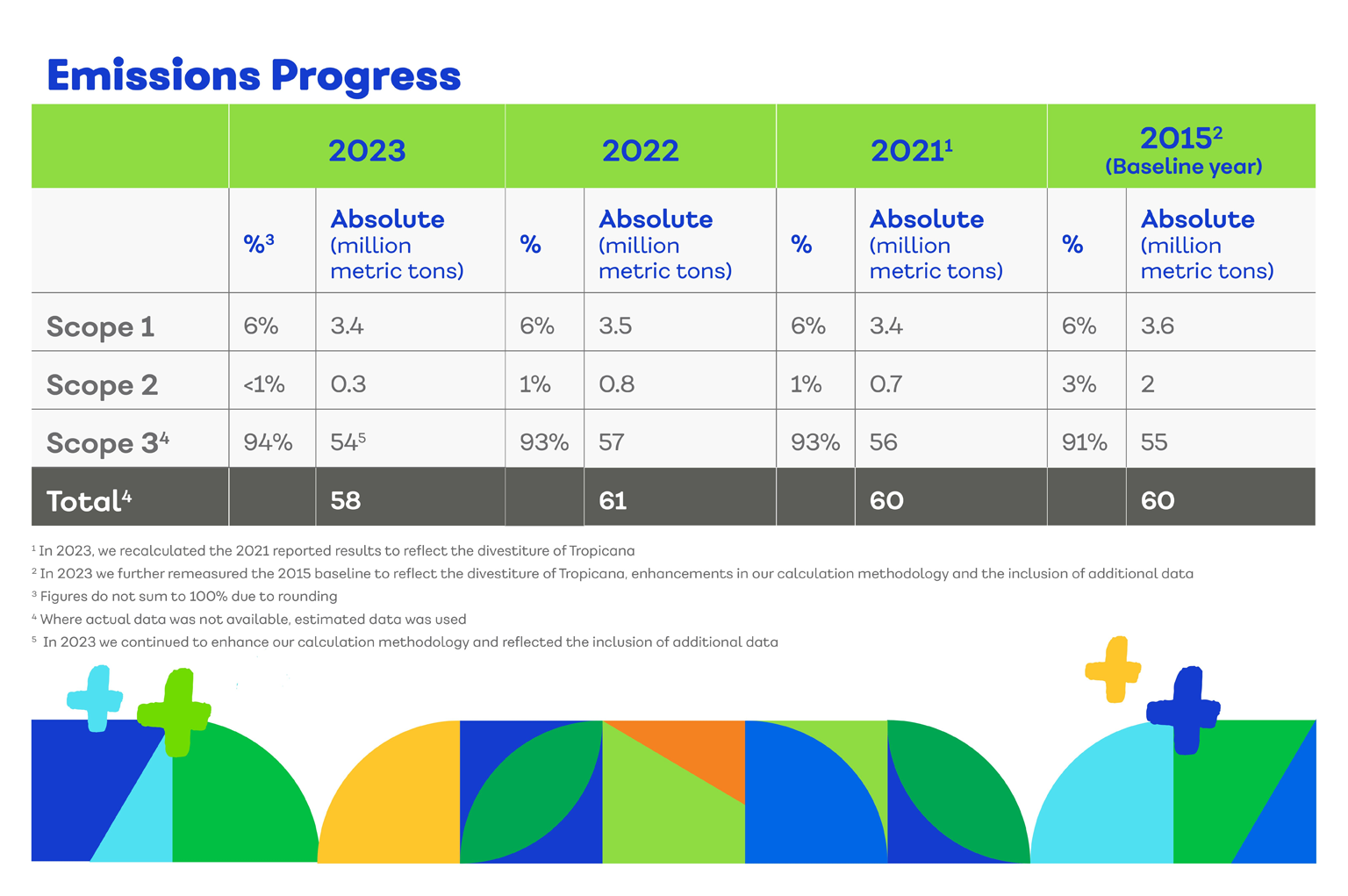
PepsiCo continues to be recognized for its climate strategy. Since 2017, we have received an A- or better on our annual CDP Climate Change submission. In 2021, PepsiCo received the inaugural Terra Carta Seal from His Majesty King Charles III in his former role as The Prince of Wales, which recognizes organizations that have made a serious commitment to a future that is more sustainable.
Between fuel consumption and electricity use in our company-owned operations, we used approximately 76 million gigajoules of energy in 2023. Combined, our 2023 Scope 1 and 2 emissions were down 33% against our 2015 baseline.5
Scope 1
In 2023, PepsiCo’s Scope 1 GHG emissions were approximately 3.4 million metric tons, down approximately 6% from the 2015 baseline.
Our Cork, Ireland facility became the first PepsiCo manufacturing location to eliminate the use of fossil fuels in our operations by transitioning to hydrotreated vegetable oil (HVO) to replace natural gas in heat generation. By the end of 2023, the facility reduced its Scope 1 and 2 emissions by 85% compared to a 2015 baseline. We continued to focus on piloting new technologies like biomass, biogas, renewable natural gas, electrification and hydrogen opportunities, while investing in capability-building and knowledge-sharing internally to identify and deploy low-carbon solutions. For more information on our progress for sustainable fuel use in our operations, see Renewable energy.
We have also made significant improvements in fleet GHG intensity over the years. This was achieved by diversifying the types of fuels we use, improving fuel economy, right-sizing vehicles and transitioning to zero-emissions vehicles. For more on our industry-leading efforts to reduce emissions from transportation and distribution, see Fleet decarbonization.
Scope 2
In 2023, PepsiCo’s Scope 2 (market-based) GHG emissions were approximately 300,000 metric tons, down 84% from the 2015 baseline. After transitioning our U.S. direct operations to sourcing 100% renewable electricity (including renewable energy credits) in 2020, we set our sights more broadly and by the end of 2023, 40 countries in PepsiCo’s operations consumed 100% renewable electricity, including on-site solar, off-site power purchase agreements and renewable energy credits, for both manufacturing and non-manufacturing facilities. For more information on our progress adopting renewable electricity, see Renewable energy.
In 2023, we set new guiding principles for our operations, called Sustainable Operations from the Start (SOftS), that require all new operations, including building new manufacturing and distribution sites as well as expanding lines within existing operations, to be funded, scoped and activated with net-zero emissions and net water positive outcomes in mind. SOftS requires that, at start-up, new operations within PepsiCo have zero incremental manufacturing emissions, are net water positive and are modern and fully digitally-connected. Additionally, SOftS asks that new projects build in space for evolving future solutions. While the desired outcomes are prescribed through SOftS, the solutions to get there are not — each project and each sector can design their operations to match the capabilities and technologies available within the market.
Scope 3
In 2023, our Scope 3 emissions were 54 million metric tons, down approximately 1% against the 2015 baseline3 and down 4% from 2022.4
Like many large, global organizations, reducing Scope 3 emissions is the biggest challenge we face in advancing progress toward our 2040 net-zero goal. Given the indirect nature of these emissions, quantifying and managing them is difficult and requires strategic partnerships and engagement.
We work with our value chain partners — including suppliers, contract manufacturers, franchise bottlers and customers — with the aim to help them improve the sustainability of their operations.
A point of light in our Scope 3 emissions efforts is our continued progress with vending and cooling equipment in retail, in which we reduced GHG emissions by 63% in 2023 compared to 2015. This was achieved by replacing current models with more energy-efficient ones and migrating into hydrofluorocarbon (HFC)-free refrigerants, all compliant with the latest standards of DOE2017 and e-star3. In 2023, we assessed the energy efficiency of our coolers by completing a year-long joint assessment with one of our bottlers in Europe, Royal Unibrew, of past, current and future GHG outlooks. Findings are helping us prioritize more efficient technologies in the future which are expected to reduce related emissions by more than 30% between 2023-2030.
While our efforts in sustainable agriculture help to mitigate our Scope 3 emissions associated with agriculture, business growth in 2023 was accompanied by a growth in purchased goods. Overall, we have reduced GHG emissions from agriculture 2% compared to our 2015 baseline. We have helped to spread the adoption of regenerative agriculture in more than 1.8 million acres6 as of the end of 2023. In these projects, we work with our partners to carefully measure and monitor GHG emissions, collate data at the end of the growing season and determine the change in emission factors related to the growing of these crops over time. We have also worked with farmers across the globe to plant cover crops on more than a million acres of land, resulting in an estimated total of more than a 951,000 metric ton net reduction in on-farm GHG, including soil carbon sequestration.7 While we are pursuing our ambitious goal of rolling out regenerative agriculture in our supply chain, sequestered carbon from these efforts will not be accounted for in our Scope 3 results until the GHG Protocol finalizes its guidance for carbon removal and PepsiCo finalizes and validates a FLAG (Forest, Land and Agriculture) target.
In 2023, we supported the development of the Climate Resilience Platform — lead by the Alliance Bioversity-CIAT. This tool, part of our broader value-chain engagement toolkit, helps translate climate research into actionable insights for companies to create a resilient agricultural supply chain and farming system for climate change adaptation.
Packaging represented 26% of our total 2023 GHG emissions, up from 23% in 2015. While we continue to strive to reduce absolute tonnage of virgin plastic derived from non-renewable sources, business growth in 2023 paired with consumer trend toward single-serve package sizes meant that our overall packaging footprint grew from the prior year. That growth was accompanied by commensurate GHG emissions growth. Our sustainable packaging vision includes a focus on developing and deploying disruptive sustainable packaging materials and new models, including reusable packages, that we expect will reduce our reliance on single-use plastics and packaging. We anticipate that progress made on this goal will have the additional benefit of reducing our Scope 3 emissions from packaging. For more information on our packaging journey, see Packaging.
Third-party logistics remain a key area of focus for GHG reductions. In 2023, Frito-Lay North America products were delivered through third-party transportation on an electric vehicle for the first time, in partnership with Schneider National. As the first company to contract transport on Schneider’s eCascadia fleet, our collaboration serves as a blueprint for how we can work alongside our transportation partners to build a sustainable food system and reach our climate ambitions. Even with this promising progress, fleet technology, vehicle development — particularly for low- or zero-emission class 8 vehicles — and alternative fuel availability are not yet at the scale needed for our logistics partners to adopt.
Engaging our value chain in our climate ambitions continues to play a role in our Scope 3 emissions action plan. In 2023, 44% of our top 200 suppliers2 had set science-based targets, 60% shared their GHG emissions with us and 49 suppliers had participated in S-LOCT training.
Additionally, we launched a supplier survey which allows us to monitor, report and track progress. The survey positions them on a “Leader Ladder” which is defined against five categories; initiating, engaging, progressing, accelerating or leader. Understanding and meeting our suppliers where they are, can provide us with greater insight and the ability to create deeper engagement and collaborative opportunities.
After launching pep+ REnew in 2022, we developed a central platform with the aim to scale climate solutions in our value chain: Partners for Tomorrow - Sustainability Action Center. The platform provides our value chain partners with tailored resources and their own access to the pep+ dashboard, as well as a benchmark on how they are performing against peers and industry. Partners for Tomorrow – Sustainability Action Center also includes programs like the Supplier Leadership on Climate Action learning platform, REnew and external tools to evaluate and measure GHG emissions and learnings from our ReCon program that may be useful to our manufacturing partners.
For more on our strategy to engage suppliers, see Sustainable sourcing.
Internal carbon pricing
In 2021, we launched an internal carbon price through our Business Travel Inset Program (B-TIP), which is helping us balance out the carbon ‘cost’ of our business air travel. With B-TIP, we have added a carbon fee to the cost of each flight undertaken by employees for business travel. Collected fees, borne by the traveling employee’s sector, business unit or function, are then reinvested into regenerative agriculture projects that aim to reduce carbon emissions. In addition, we have been continuously refining the tools and metrics that PepsiCo uses to evaluate and justify investments like our Green Bond and sustainable CAPEX — including a cost-of-carbon calculator.

As we pursue our climate ambition, we have made progress, yet face challenges along the way.
Progress
- In 2023, approximately 80% of the company’s direct global electricity needs were met with renewable electricity. Our operations in 40 countries used 100% renewable electricity, including renewable energy credits.
- In 2023, Frito-Lay North America products were delivered through third-party transportation on an electric vehicle for the first time, in partnership with Schneider National.
- We established guiding principles — Sustainable Operations from the Start — that require all new operations, including building new manufacturing and distribution sites as well as expanding lines within existing operations, to be funded, scoped and activated with net-zero emissions and net water positive outcomes in mind.
- Our facility in Cork, Ireland became fossil fuel-free in 2023 and has transitioned away from natural gas by pioneering the use of HVO to power the facility’s operations.
Challenges
- System solutions needed to scale decarbonization of transport include cost-competitive Class 8 EV trucks, charging infrastructure and market development for sustainable biofuels. While progress has been made, these system developments must move faster.
- Our value chain is large and complex. Making progress against our climate goals means pursuing multiple initiatives across different areas of our value chain while maintaining internal stakeholder alignment and expanding collaboration with our suppliers, peers and other industry partners.
Strategic partnerships
While we strive to reduce our own impact, we believe that effectively addressing climate change also requires a collective response. To this end, we engage regularly with industry, non-governmental organizations and other stakeholders to promote actions that protect the climate and we have a long record of supporting climate policy. Across all of our partnerships, we focus our work on designing, launching and scaling holistic solutions to complex challenges, investing alongside key stakeholders across all levels and leveraging external technical and financial resources to deliver outcomes that reduce climate risk, increase resilience and drive mitigation and long-term sustainability. For more detail on a selection of these partnerships, see Climate partnerships and engagement.
What's next?
Striving toward our climate goals is a key priority under pep+. To this end, we expect to focus on the following priorities in the coming year:
- Renewable energy within our operations;
- Scaling up regenerative practices across our agricultural supply chain;
- Supplier engagement and partnerships within our agricultural and packaging supply chains;
- Material reduction and recycled content in our packaging;
- Opportunities to decarbonize transportation and distribution; and
- Engagement with third-party manufacturers on operational efficiencies and renewable energy.
2By GHG impact
3In 2023, we continued to enhance our calculation methodology and reflected the inclusion of additional data. Where actual data was not available, estimated data was used
4In 2023, we further remeasured the 2015 baseline to reflect the divestiture of Tropicana, enhancements in our calculation methodology and the inclusion of additional data. Where actual data was not available, estimated data was used
5Measured versus a 2015 baseline
6PepsiCo considers an acre as delivering regenerative impact when the adoption of regenerative agriculture practices results in quantified improvements across at least two of the environmental outcome areas, with a strong preference for removing or reducing GHG emissions to be one impact area. Refer to PepsiCo's Regenerative Agriculture Practice Bank for a comprehensive listing of practices directly or indirectly linked to the five impact areas. Regenerative acres reported represent the annual count in each year presented based on actions undertaken since 2021
7Carbon sequestration from regenerative agriculture projects is calculated separately and outside of PepsiCo's GHG inventory. Carbon sequestration is not currently factored into PepsiCo's climate goal results
Downloads
Last updated
June 19, 2024